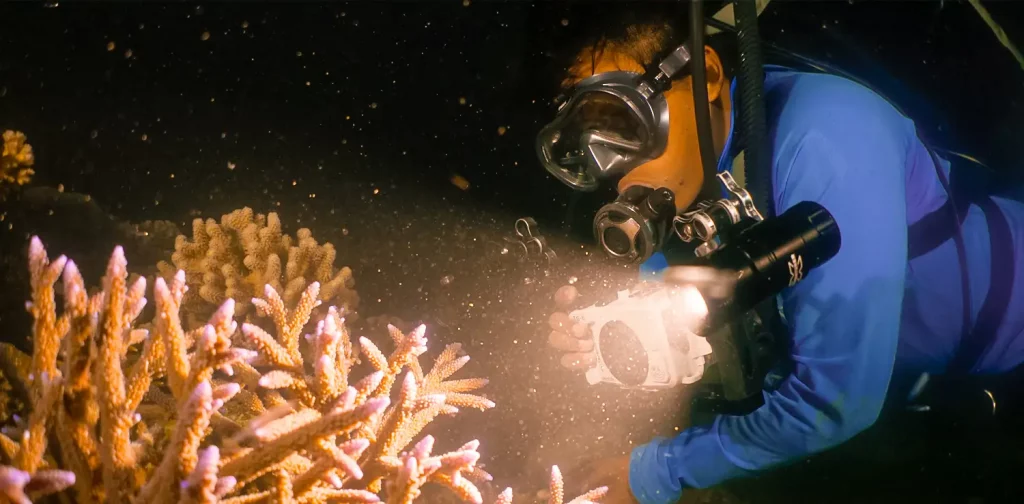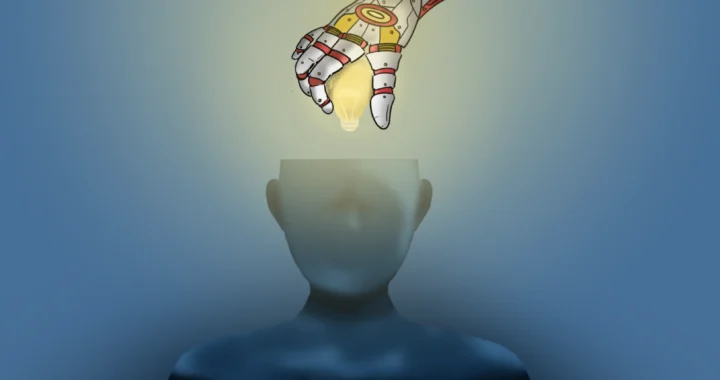Fitzroy Island Nursery Coral Spawning Sparks Hope for the Great Barrier Reef

Marine biologist Azri Saparwan witnessing a coral spawning event at the Fitzroy Island coral nursery. | Reef Restoration Foundation.
A picture-perfect underwater scene usually involves colorful corals and fishes surrounded by the clear blue ocean. More than their beauty, corals are also home to about a quarter of the world’s marine species and protectors of our coastlines against erosion and flooding.
Unfortunately, climate change is threatening the existence of coral reefs around the world, including the Great Barrier Reef in Australia.
Coral Bleaching & Restoration
Coral bleaching occurs when the water temperature rises, and corals get stressed. Their stress response is to expel the zooxanthellae algae which give them colors, so they turn white.
In March, a mass bleaching event in the Great Barrier Reef happened during a previously-hoped recovery period of a cooler La Niña year. It was the fourth mass bleaching event since 2016.
“The increasing frequency of warming ocean temperatures and the extent of mass bleaching events highlights the critical threat climate change poses to all reefs,” said AIMS’s Long-Term Monitoring Program Leader Dr. Mike Emslie. “Future disturbance can reverse the observed recovery in a short amount of time.”
However, the Great Barrier Reef seems to be slowly recovering. In August, the Australian Institute of Marine Science (AIMS) reported the highest-ever recorded coral cover in the northern and central Great Barrier Reef. Additionally, captive-raised corals in an experimental aquarium, the SeaSim, spawned for the first time months before the annual reproductive season.
Coral Spawning at an Offshore Nursery
Coral spawning is when corals release bundles of eggs and sperm into the water to fertilize. The fertilized eggs turn into coral larvae, then settle onto a surface and grow. This event only happens once a year after a full moon with the right water temperatures.
The night of November 12 was a joyous time. Acropora corals at the Fitzroy Island coral nursery on the Great Barrier Reef spawned for the first time since they were planted four years ago. It marked the start of a coral spawning event, with the outer reef expected to reproduce during December’s full moon.
Azri Saparwan, a marine biologist who witnessed this event, was over the moon. He said, “Watching our coral babies reproduce for the first time to create the next generation of corals was a beautiful and humbling experience.”
He was a part of the Reef Restoration Foundation (RRF) team that planted the corals in 2018 at a pilot research offshore nursery. He explained, “We planted coral cuttings in a degraded patch of reef. These pioneer species have grown to around 1m in diameter, helping to create a healthy and complex habitat for various corals and marine life.”
Coral spawning was their second goal, and they succeeded. RRF CEO Ryan Donelly attributed this progress to the corporate sponsors and the community.
“It is a community effort as we receive no government funding. We rely on the support of around 50 volunteers, with about one-third of these experienced divers working in the tourism industry,” he said. “We need to drastically reduce global emissions, but at the same time, work collaboratively to build the resilience of the places we love. We all have a role to play.”

Join Green Network Asia Membership
Amidst today’s increasingly complex global challenges, equipping yourself, team, and communities with interdisciplinary and cross-sectoral insights on sustainability-related issues and sustainable development is no longer optional — it is a strategic necessity to stay ahead and stay relevant.
Join Now
Nazalea Kusuma
Naz is the Manager of International Digital Publications at Green Network Asia. She is an experienced and passionate writer, editor, proofreader, translator, and creative designer with over a decade of portfolio. Her history of living in multiple areas across Southeast Asia and studying Urban and Regional Planning exposed her to diverse peoples and cultures, enriching her perspectives and sharpening her intersectionality mindset in her storytelling and advocacy on sustainability-related issues and sustainable development.


 Weaving the Thread Between the Last Elephant and the Floods in Sumatra
Weaving the Thread Between the Last Elephant and the Floods in Sumatra  Prescribing Beyond Profit for CEOs’ Anxiety
Prescribing Beyond Profit for CEOs’ Anxiety  An Interview with May Tan-Mullins, CEO and Provost of University of Reading Malaysia
An Interview with May Tan-Mullins, CEO and Provost of University of Reading Malaysia  An Interview with Eu Chin Fen, CEO of Frasers Hospitality
An Interview with Eu Chin Fen, CEO of Frasers Hospitality  The UK Government’s Funding Package Plan to Tackle Youth Unemployment
The UK Government’s Funding Package Plan to Tackle Youth Unemployment  Understanding the Dark Side of Artificial Intelligence
Understanding the Dark Side of Artificial Intelligence